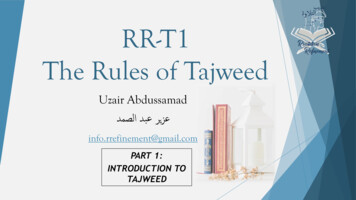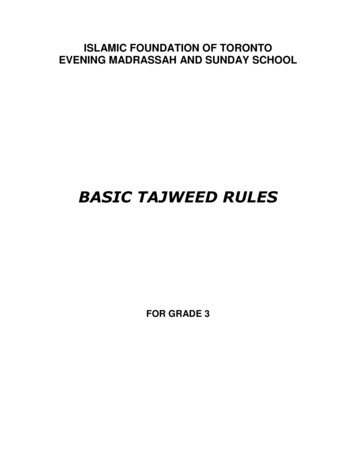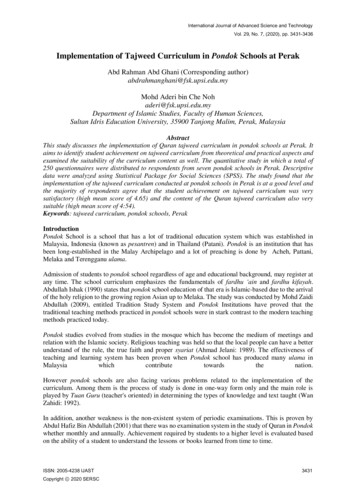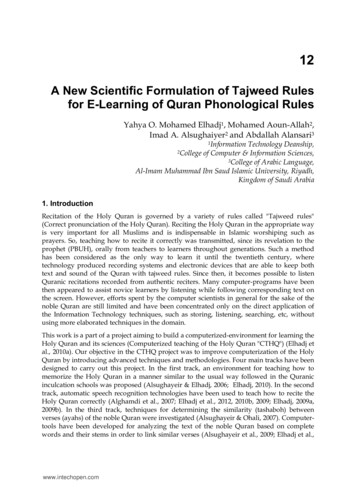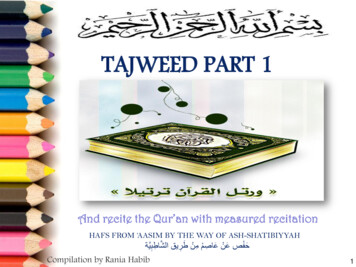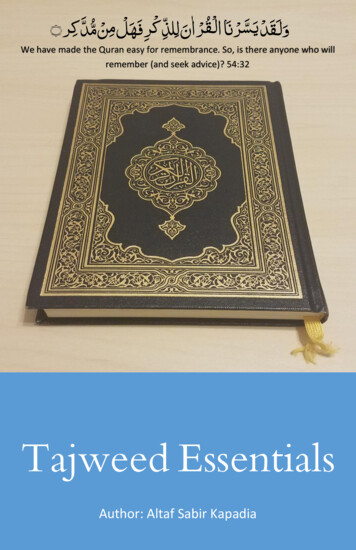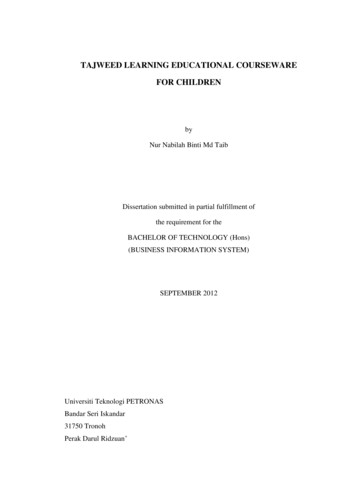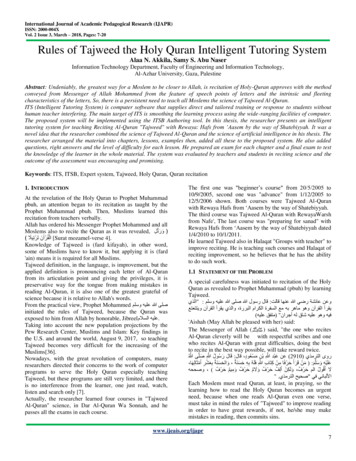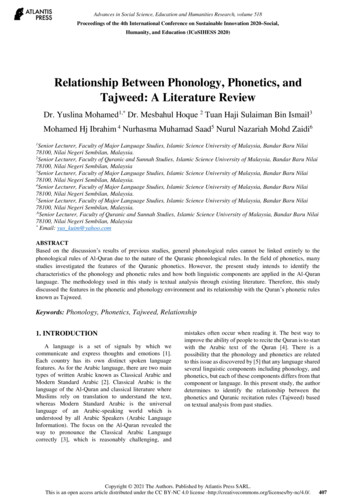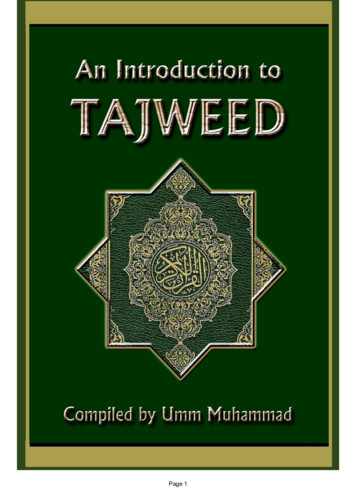
Transcription
Page 1
An Introduction toTAJWEED مختصر أحكام التجويد Compiled byUmm MuhammadPage 2
All rights reserved. No part of this publication may be reproduced,translated, stored in a retrieval system or transmitted in any form or by anymeans – electronic, mechanical, photocopying, recording or otherwise –without written permission from Dar Abul-Qasim. This includes the scanning,uploading and free distribution of its contents via the internet. If you'veobtained an electronic copy without paying for it, please replace it bypurchasing a licensed e-book on our website. DAR ABUL-QASIM, 20152 nd edition, in print since 1993King Fahd National Library Cataloging-in-Publication DataUmm MuhammadAn Introduction to Tajweed/Umm Muhammad Jeddah,201558 pp., 14 x 21 cmISBN 978-9960-1–l – TitleLegal Deposit no. 1436/DAR ABUL-QASIMPO Box 6156Jeddah 21442, Saudi ArabiaTelephone (966-2) 671-4793Fax (966-2) ks.comTMProfessional Editing and Typesetting of Islamic LiteraturePage 3
"Whoever recites the Qur’an being skillful in it will bewith the honorable messenger-angels.And whoeverrecites the Qur’an with hesitation as it is difficult for himwill have a double reward."(A ḥadīth narrated by al-Bukhārī, Muslim, at-Tirmidhī and Ibn Mājah.)***To every brother and sister who has felt the handicap ofa foreign tongue.To every Muslim whose love of the Qur’ān has urgedhim to overcome his own limitations, trusting that rewardis in proportion to effort, striving and reaching out toAllāh.With His help, nothing is impossible.Page 4
Page 5
Table of ContentsA Brief Introduction to Tajweed . 1A Chart of Arabic Letters and Symbols . 2Section One: Pronunciation of Arabic LettersMakhaarij . 5Ṣifaat . 11Opposite Ṣifaat . 11Ṣifaat Without Opposites . 13Additional Notes Concerning Specific Letters . 16Section Two: Preparing for RecitationSeeking Refuge . 18Pronouncing the Name of Allāh. 18Stops . 19Pauses . 20Section Three: Basic Rules of TajweedTafkheem and Tarqeeq . 22The Rule of Laam . 23The Rule of Raa . 24Qalqalah . 26Ghunnah . 27Rules of Noon Saakinah and Tanween . 28Ith-haar . 28Idghaam . 29Iqlaab or Qalb . 31Ikhfaa’ . 32Rules of Meem Saakinah . 33Idghaam Shafawi . 33Ikhfaa’ Shafawi . 33Ith-haar Shafawi . 34Page 6
Other Types of Idghaam . 35Idghaam of Two Identical Letters . 35Idghaam of Two Similar Letters . 35Idghaam of Two Proximities . 36Idghaam of Laam in the Definite Article . 37Rules of Madd . 38Aṣli (Original) or Ṭabee‘i (Normal) Madd . 39Badal: Substitute Madd . 39‘Iwadh: Replacement Madd . 40Small Ṣilah Madd . 40Far‘i: Derived Madd . 42Muttaṣil: Connected Madd . 42Munfaṣil: Separated Madd . 42Greater Ṣilah Madd . 43‘Aaridh: Madd Exposed to Sukoon . 43Leen: Madd of Ease. 44Laazim (Compulsory Madd) in Words . 45Laazim (Compulsory Madd) in Letters . 45Further Information about Opening Letters . 46Final Du‘aa’ . 47Glossary of Commonly Used Arabic Terms . 48References . 50Page 7
بسم اهلل الرمح ن الرحيم A BRIEF INTRODUCTION TO TAJWEEDThe general linguistic meaning of tajweed is "excellenceand precision." In specific Islamic terminology it is defined as:"the recitation of the Qur’ān as it was revealed to Muḥammad,the Messenger of Allāh ( )," or more specifically, "givingevery letter its right," i.e., observing its correct pronunciationand special qualities, as well as proper length, appropriateassimilation, etc.,1 as in-shā-Allāh will be summarized in thesepages. The more important Arabic terms have been included tofamiliarize them to the student.As the title suggests, this booklet is no more than anintroduction to the theoretical aspect of recital. The practicalapplication of these rules during Qur’ān recitation, which is theultimate aim of this study, cannot be mastered except by hearingand repeating, which necessitates oral examination by a teacher.The correct method of recitation is indeed a sunnah which hascome down to us orally through an unbroken chain of qualifiedreciters going back to the Prophet himself ( ).Scholars have defined the Qur’ān as: "the words of Allāhrevealed to Muḥammad ( ), the recitation of which is a form ofworship."2 This definition can be applied to no other book orspeech. And recitation, as all worship, requires correctness asfar as possible.An explanation in English is only an aid to those Muslimswho are not yet familiar with the Arabic language, and as asupplement to that of an instructor. It follows the qiraa’ah(reading) of "Ḥafs taken from ‘Aaṣim ( )حفص عن عاصم ," whichis the one widely taught in most of the Muslim world today. Ifit should prove beneficial, then all praise is due to Allāh. Weask Him to forgive our shortcomings and accept our efforts.1Al-Mukhtaṣar al-Mufeed fi ‘Ilm it-Tajweed, p. 8.Mabāḥith fi ‘Ulūm il-Qur’ān, p. 21.21Page 8
Arabic Letter orMark ( ى ا vowel) ب ت ة ث ج ح خ د ذ ر ز س ش ص ض ط ظ ع غ ف NamealifSymbol Used inThis ghfaaf2Page 9ā
Arabic Letter orMarkNameSymbol Used inThis Text ق qaafq ك ل م ن ه و (as vowel) و ي (as vowel) ي ء aoryeeorīhamzah’fat ahakasrahidhammahushaddahdoubled lettersukoonabsence of vowel3Page 10
Page 11
Sect io n O nePRONUNCIATION OF ARABIC LETTERSIn order to acquire the proper pronunciation of Arabicsounds, it is imperative that one hears them repeatedly and thenpractices until precision is attained. This is true even for Arabicspeaking people when they undertake the study of tajweed,since modern dialects have deviated from the pure classicalArabic of the Qur’ān, and since some letters have taken ondifferent pronunciations in colloquial speech. The teacher,therefore, must be one who himself has learned correctpronunciation, not depending solely on a knowledge of modernwritten Arabic.No attempt has been made here to give approximatephonetic equivalents to Arabic letters in other languages. Thatmethod, although acceptable as an aid to the student of ordinarymodern Arabic, does not give the accuracy required for tajweed.As a supplement to audio-vocal training, tajweed studiesinclude both pinpointing the makhraj (point of articulation ofeach letter [plural makhaarij]) and defining certain qualities orcharacteristics (ṣifaat) of each letter which distinguish it fromother sounds.MAKHAARIJ ( )الْ َم َخ ار ج In the human body, the area of speech is divided into fivemain sections:2. al-ḥalq ْال َجوْ ف ْال َح ْلق 3. al-lisaan اللِّ َسان 1. al-jawf4. ash-shafataan5. al-khayshūmthe interior or chest areathe throatthe tongue ال َّشفَتَان ْال َخ ْي ُشوم the lipsthe nasal passage5Page 12
These are further subdivided into a total of seventeensubsections which are the actual points of articulation. They arelisted in order (from innermost to outermost) below, along withthe letters which are formed in each makhraj:The interior is one makhraj for three letters:1. – ْال َجوْ ف The interior is one makhraj in itself and includesthe empty area of the open mouth. From it emerge thevowel sounds of ( ا alif ) pronounced "aa," ( و waaw)pronounced "oo," and ( ي yaa) pronounced "ee."This makhraj is an estimated or approximate one ( )تَ ْقديري while all others are true or actual ( ) َحقيقي because they applyto consonant sounds and can be pinpointed more accurately.The throat section contains three makhaarij for six letters:2. صى ْال َح ْلق َ – أَ ْق The deepest part of the throat is the makhrajof ( ء hamzah), a glottal stop (pronounced in English at thebeginning of words that start with vowels such as: ate, eat,out). It is a true written consonant in Arabic and must bepronounced clearly whether it occurs at the beginning,middle or end of a word.From this section of the throat also, but slightly higher,emerges ( ھ haa).3. سطُ ْال َح ْلق َ – َو The mid-throat is the makhraj of ‘( ع ayn) andjust above it, ( ح ḥaa), a sharper "h" sound than ھ .4. – أَ ْدنَى ْال َح ْلق The nearest part of the throat (to the mouth) isthe makhraj of ( غ ghayn) followed by ( خ khaa).33A common error in the pronunciation of ghayn and khaa is caused byallowing them to emerge from the mouth rather than the throat.6Page 13
The tongue contains ten makhaarij for eighteen letters:5. سان م َّما يَلي ْال َح ْلق َ ِّ صى الل َ – أَ ْق The innermost part of thetongue next to the throat along with what corresponds (i.e.,is opposite) to it from the roof of the mouth. This is themakhraj of ( ق qaaf ).6. سان م َّما يَلي ْالفَم َ ِّ صى الل َ – أَ ْق The innermost part of the tonguetoward the mouth and what corresponds from the roof ofthe mouth is the makhraj of ( ك kaaf ).7. – َو َسطُ اللِّ َسان The middle of the tongue: the upper surface( سان َ ِّ )ظَ ْه ُر الل with what corresponds from the roof of themouth is the makhraj of ( ج jeem), ( ش sheen) andwhen it begins a syllable as the consonant "y."4 ( ي yaa)8. سان أَوْ َحافَّتَاه َ ِّ – َحافَّةُ الل One or both edges of the tongue alongwith the upper back molars (more often on the left side) isthe makhraj of ( ض dhaad).9. سان َ ِّ – َحافَّةُ الل Between the edge of the tongue (usually theright side) and the gums of the upper front molars, canineteeth and incisors is the makhraj of ( ل laam).10. سان َ ِّ – َر ْأسُ الل Between the tip of the tongue and the gums ofthe two upper central incisors is the makhraj of ( ن noon).11. سان م َّما يَلي ظَ ْه َره َ ِّ – َر ْأسُ الل Between the upper part of the tipof the tongue and the gums of the two upper central incisorsemerges the letter ( ر raa).4When occurring as a vowel (i.e., "ee") yaa emerges from al-jawf (theinterior).7Page 14
12. سان َم َع ظَ ْهره َ ِّ – َر ْأسُ الل Between the tip including a portionof the upper surface of the tongue and the roots of the twoupper central incisors is the makhraj of ( ط ṭaa), ( د daal)and ( ت taa).13. ب منَ الثَّنَايَا ٍ – َر ْأسُ اللِّ َسان َم َع قَري The tip of the tongue nearthe inner plates of the upper central incisors is the makhrajof ( ص ṣaad), ( س seen) and ( ز zaay).14. سه َ – ظَ ْه ُر اللِّ َسان م َّما يَلي َر ْأ Between the upper surface of thetongue near the end and the tips of the two upper centralincisors is the makhraj of ( ظ thaa), ( ذ dhaal) and ث (thaa).From the lips come four letters:َّ – بَ ْينَ ال Between the two lips is the makhraj of ب 15. شفَتَين (baa), ( م meem), and ( و waaw) when it begins a syllable asthe consonant "w."5ْ َ – ب Between the inside of the lower lip and16. س ْفلَى ُّ ط ُن ال َّشفَة ال the tips of the upper incisors is the makhraj of ( ف faa).The nasal passage:ُ – ْال َخ ْي The nasal passage, which like the interior is a17. شوم single makhraj, is the makhraj of ( ْال ُغنَّة al-ghunnah).Al-ghunnah is not a letter but a quality belonging to theletters ( ن noon) and ( م meem), a sound coming from thenose in which the tongue has no part. It is said to resemble5When occurring as a vowel (i.e., "oo"), waaw emerges from al-jawf (theinterior).8Page 15
the voice of a female gazelle if her child is lost. It will bedealt with further in sections on noon and meem.NOTE: In order to feel the makhraj of a given letter, pronouncethat letter with sukoon preceded by hamzah – forexample, say: ْ إح ، ْ إص ، ق ْ إ The instructor will help if any adjustment of themakhraj is necessary.9Page 16
A DIAGRAM SHOWING THE MAKHAARIJ OF LETTERS10Page 17
ṢIFAAT ( صفَات ِّ )ال The second study pertaining to pronunciation is that ofṣifaat (singular: ṣifah, meaning description, characteristic,attribute or quality). Here the word ṣifaat (or ṣifah) refers to thespecial characteristics or qualities found in each letter.The purpose of defining ṣifaat is first, to make sure they arepresent during pronunciation and second, to differentiatebetween letters whose origin is in the same makhraj, such as ت and ط , ذ and ظ , or س and ص . When a letter emergesfrom the correct makhraj and all its ṣifaat (qualities) areobserved, then accurate pronunciation is obtained.Ṣifaat are of two types: permanent ( ) الصفات الالزمة andtemporary ( ) الصفات العارضة . The latter will be described underthe sections dealing with the rules of tajweed.Permanent qualities, however, are those inherent in theletter, without which correct pronunciation will not be realized.Most scholars give their number as seventeen, ten opposite toeach other (i.e., five pairs) and seven singles (with noopposites). Every letter has at least five ṣifaat (i.e., one fromeach pair of opposites), and many have an additional singlequality as well, with the letter ( ر raa) having two additionalsingle qualities. (See table on page 14)The following is a list of the permanent qualitiesُ َ صف ( ات الالز َمة ِّ )ال and the letters which carry them.OPPOSITE ṢIFAAT1. – ا ْلهَ ْمس Whispering: a flow of breath during pronunciation –ْ فَ َحثَّهُ َش ْخص َس َك a quality of the letters contained in the phrase: ت 2. – ْال َجهْر Audibility: trapping the flow of breath due to aheavy dependence on the makhraj – a quality of all otherletters not included under whispering.11Page 18
ِّ – ال Strength (or force): trapping the flow of sound in the3. ش َّدة makhraj – a quality of the letters in the phrase: ت ْ أَج ْد قَ ٍط بَ َك 4. – ال َّرخَا َوة Weakness (or looseness): a flow of sound duringpronunciation – Between the two opposites of strength andweakness falls a third quality: moderation – التَّ َوسُّط , wherethe sound emerges but does not flow. The letters ofmoderation are ع َمر ُ لن , and those of weakness are all of theletters not included under the categories of strength andmoderation.5. – االسْتع َْالء Elevation: raising the tongue to the roof of themouth during the emergence of the letter – This qualityْ ض ْغ ٍط ق belongs to the letters in the following phrase: ظ َ َّ ُخص 6. – االسْتفَال Lowness: lowering the tongue to the floor of themouth – It includes all letters other than those of elevation.ْ – ال Closing: the meeting of the tongue and what is7. طبَاق opposite it from the roof of the mouth – Its letters are four: ص , ض , ط and ظ .8. – اال ْنفتَاح Opening: the separation of the tongue from theroof of the mouth – It includes all letters other than ص , ض , ط and ظ .(A final pair is not included in tajweed study but ismentioned only for the sake of completing the descriptivequalities. It is:)9. – ال ْذالق Fluency: the easy flowing of the letters ْ فَ َّر م ْن لُب from the tip of the tongue and lips12Page 19
10. – الصْ َمات Restraint: the emergence of the remainingletters from inside the mouth and throatṢIFAAT WITHOUT OPPOSITES11. – الصَّفير Whistling: a sound emerging between the tip ofthe tongue and the upper central incisors which resemblesthe sound of a bird – It is a quality of the letters ص , س and ز . (With ز it is more a buzzing sound.)12. – القَ ْلقَلَة Vibration (or unrest): the vibration of the makhrajwith the emergence of the letter when accompanied bysukoon ( ), a breaking of tension or release – Its letters areْ ُ ق . This quality will be discussed further infive: طبُ َج ٍد another section.ْ13. – اللِّين Ease (softness): pronunciation without exertion ordifficulty – This is a quality of ْ ( َو waaw with sukoonpreceded by fatḥah) and ْ ( َي yaa with sukoon preceded byfatḥah). These are not to be confused with the vowelsounds of ْ ُو and ْ ِي which will be discussed under thesection of madd ( ) ْال َمد .14. – اال ْنح َراف Inclination: the inclination of the letter after itsemergence from the makhraj toward another makhraj –This is a characteristic of ل and ر . ( ل inclines toward thetip of the tongue, and ر inclines back toward the makhrajof ل .)15. – التَّ ْكرير Repetition: the natural tendency to vibrate or rollthe tongue when pronouncing the letter – ر Correct13Page 20
pronunciation, however, requires the prevention oravoidance of this quality by controlling the tongue and notrelaxing it.ِّ َ – التَّف Diffusion: the spreading of air throughout the16. شي mouth during pronunciation – This is a quality of ش .17. – االسْتطَالَة Elongation: the extension of sound over theentire edge of the tongue from front to back – This is aquality of ض and is most noticeable when it isaccompanied by a sukoon, as in the words ُ يَضْ رب andَ يَضْ َح ُكون .NOTE: The ṣifaat of any letter are most evident when pronouncingْ إ it with a sukoon. For example: ْ إب ، ْ إش ، ظ 14Page 21
A TABLE SHOWING THE ṢIFAAT OF EACH LETTER ب ت ث ج ح خ د ذ ر ز س ش ص ض ط ظ ع غ ف ق ك ل م ن ه ﹶو ﹶي ء RESTRAINT15Page 22VIBRATIONVIBRATIONVIBRATIONVIBRATIONREPETITION
ADDITIONAL NOTES CONCERNINGSPECIFIC LETTERS1. We notice from our study of makhaarij and ṣifaat that theletters و and ي serve two functions: as consonants(equivalent to "w" and "y") and as vowels (i.e., the sounds"oo" and "ee"). In the latter case they are referred to asletters of madd (extension or lengthening) and are alwayswritten with sukoon and preceded by a short vowel(diacritical mark) of a similar type (i.e., waaw saakinahpreceded by dhammah, or yaa saakinah preceded bykasrah) as in the word نُوْ ح ْيهَا .62. Alif is always a vowel or madd letter and is written in thesame way (i.e., alif saakinah preceded by fatḥah). It neverbegins a word since a syllable cannot begin except with aconsonant sound. If the written form of alif should occur atthe beginning of a word, it is in reality merely a support forhamzah and not a letter in its own right.3. Hamzah is also of two types:ْ َ )ھَ ْم َزةُ الق which isThe first is a regular consonant ( طع written either alone ( )ء or with a support letter – a formwhich has no function in pronunciation ( ) ئ ﺌ ؤ إ أ . Thishamzah must always be pronounced.The second type is a means for connecting certain words( )ھَ ْم َزةُ ال َوصْ ل occurring only at the beginning of a word andindicated in the muṣḥaf 7 either by the alif form alone or by6Short vowels (held during pronunciation for half the length of the maddletters ا , و and ) ي are indicated by the diacritical marks: fatḥah ( َ ),dhammah ( ُ ) or kasrah ( ِ ). Sukoon ( ْ ) represents the absence of a vowelsound or the end of a syllable. Saakinah refers to a letter accompanied bysukoon.7The Arabic volume of the Qur’ān.16Page 23
the symbol ( ) ﭐ . This hamzah is dropped during recitationwhen serving its connecting function and is pronouncedonly when beginning a new sentence or phrase (i.e., afterdrawing a breath).88For example, note the difference in pronunciation of the divine name whenbeginning ( ) ﭐهللُ نُو ُر السَّم َوات َوﭐ ْْلَرْ ض and when connected with apreceding word ( غفُور َرحيم َ َ ) إ َّن ﭐهلل .17Page 24
Section TwoPREPARING FOR RECITATIONAs in all forms of worship, the study and recital of theQur’ān must be accompanied by the correct intention – seekingthe acceptance and pleasure of Allāh. It is preferable to be in astate of wudhū’ (ablution) if possible. A manner of respect andpoliteness should be observed before the words of Allāh, theExalted.SEEKING REFUGE ( ست َعا َذة ْ )اال Allāh (subḥānahu wa ta‘ālā) has said:ِ َ فَِإ َذا قَرأت ال ُقرآ َن فَاستَعِذ بِاهللِ ِمن الشَّيط الرِجيم َّ ان َ ََ"And when you recite the Qur’ān seek refuge inAllāh from Shayṭān, the rejected."9So anyone intending to read or recite āyāt (verses) from theِ َ "( أَعوذُ بِاهللِ ِمن الشَّيط I seekQur’ān should begin by saying: الرِجي ِم َّ ان َُrefuge in Allāh from Shayṭān, the rejected.") whether startingfrom the beginning of a sūrah or from any other point.Normally it is not said aloud except in circles of learning. If oneis interrupted during reading by some necessity or speech notpertaining to Qur’ānic study, he should repeat the seeking ofrefuge before resuming recitation.PRONOUNCING THE NAME OF ALLĀH ( س َملَة ْ َ )ا ْلب After seeking refuge from Shayṭān, the reader, whenbeginning a new sūrah, says: الرِحيم ٰ الر َّ ْح ِن َّ ِ بِس ِم اهلل except in Sūrahat-Tawbah which does not begin with "Bismillāh." Whenstarting from the middle of a sūrah, he may choose to recite it or9Sūrah an-Naḥl, 16:98.18Page 25
not as he pleases, except in cases where the āyah he begins withcontains some description of Allāh (as in āyah 47 of SūrahFuṣṣilat) which should not be connected to the name of Shayṭān.After the basmalah (the saying of "Bismillāh ir-Raḥmān irRaḥeem") whenever appropriate, the actual recitation begins.STOPS ( )ا ْل َو ْقف Knowing the proper places to begin and to stop duringreading or recitation is of utmost importance in order to avoidmistakes leading to confusion or a change in meaning. Thequestion often arises concerning a long āyah where the readermust pause to draw a breath before continuing. Any point ofstarting or stopping is considered either permissible ( ) َجائز ,prohibited ( غ ْي ُر َجائز َ ) or unsuitable ( )قَبيح according to whetheror not it leads to a complete and correct meaning.A general understanding of the meanings in Arabic cankeep the reader from most serious mistakes, and additionalknowledge is gained through the tafseer (explanation) of theQur’ān. For further assistance, certain symbols have beenadded by scholars to the muṣḥaf designating information aboutthe desirability of stopping in specific places. Muṣḥafs printedin Pakistan follow a system of symbols slightly different fromthose printed in Arab countries, but the more common ones inmost muṣḥafs are as follows:ۗ ط ج ۗۗcompulsory stop to avoid altering the meaningnormal stop at the end of a sentence or thoughtpermissible stop(or ص or )ز permissible stop but preferable to continue(or )ق permissible to continue but preferable to stop19Page 26
ك observe as previous symbol in the āyah ال prohibited stop stop at either of these two places but not at bothNOTE:The sunnah of the Prophet ( ) is to stop at the end ofeach āyah regardless of its length. Therefore, we candisregard the " " ال sign in some muṣḥafs at the end ofmany short āyāt.When stopping on any word, whether at the end of an āyahor a phrase, or merely to draw a breath, the following isobserved:1. Short vowels including tanween are omitted inpronunciation from the last letter of the word. (Forْ ُمح and َ ْال َكافرُون becomesexample: ُمحيط is pronounced يط ْْ ال َكافر .) One exception is the tanween of fatḥah ( ) ُون which is pronounced when stopping as alif. (See thesection on "Replacement Madd")ً2. When stopping on taa marbūṭah ( ة or ) ة all vowels andtanween (including that of fatḥah) are omitted and the letteris pronounced as haa with sukoon ( ) ْه .10PAUSES ( س ْكت َّ )ال Sakt or saktah means a pause held for two counts (thelength of a madd letter)11 without breathing during recitation,10This does not apply, however, to taa mabsūṭah ( )ﺖ which is pronounced astaa with sukoon.11A count or movement ( ) َح َر َكة refers to the unit of measurement used toestimate the length of a sound.20Page 27
and it is symbolized by the letter س or the word س ْكتَة َ . It shouldbe observed in the following places in the Qur’ān:1. after the word ع َو َجا in sūrah 18, āyah 1 ق ْۜ ا ي َِا ۜ لَ ْم ي ْجعل ّ َل َوج َ َََّ ه 2. after the word َمرْ قَدنَا in sūrah 36, āyah 523. after the word َم ْن in sūrah 75, āyah 27 ق ْ م ٰ ن ّ َم ْر َي َد َن ه َذا َ ق ْ ويِل م ن راق َ َ َ َ َ4. after the word ْ بَل in sūrah 83, āyah 14 ْ ق جِبم ٰ َك ّ َل بل ران و َ َ ىل يهل ه َ َ َ َ5. after the word َماليَ ْه in sūrah 69, āyah 28 (according to some scholars) ق ْْْْ ك ونَّي سل َط َنِه م أَغنٰى ونَّي م لَِه َهل ََََ ه َََ َThese pauses are to prevent confusion about the meaningswhich might occur otherwise.21Page 28
Section ThreeBASIC RULES OF TAJWEEDTAFKHEEM AND TARQEEQ( )التَّ ْفخي ُم َوالتَّ ْرقيق Definitions:Tafkheemthickening or making heavy – giving the letter aquality of heaviness by elevation of the tongueTarqeeqthinning or lightening – giving the letter a qualityof lightness by lowering the tongue away from theroof of the mouth1. Letters having the quality of elevation ( )االسْت ْع َالء , i.e., theْ ض ْغ ٍط ق letters ظ َ َّ ُخص , are also called letters of tafkheem(heaviness) because all of them are heavy whetheraccompanied by a short vowel or a sukoon. The heaviest ofْ )ال , which are ص ض ط ظ ,them are those of closing ( طبَاق since the tongue is then in the highest position against theroof of the mouth. Tafkheem is most emphasized in anygiven letter when it carries a fatḥah followed by alif, nextwhen it carries only a fatḥah, next when it carries a dhammah,then sukoon, and least of all with a kasrah. Practice saying: َضرب َب خ َط َئ ۜة ص ِلين ََ خ َََّ الض لَّني َ َص َد َيني ََََ َََْْْْۜ أَظلم ي ل الق َّ َإخراج َطب ي الط َع م الص َل َة آن ر َ ه َََّ ه َ َ ه ٌََۜ ف خلق يدر ظهر غدي ْْ آئ ط م ْي ل و ف ط ق ََ َ َ َ َ َ ََ َط َف َ ََ َ ََ َّ ََ َ2. Letters having the quality of lowness ( )االسْتفَال , i.e., theremaining consonants, are called letters of tarqeeq(lightness) and must always be pronounced with the tonguelowered (except for the letters ل and ر which, in certain22Page 29
circumstances, alternate between tarqeeq and tafkheem.Practice saying:ْ ا هدون الس ون د م ح ال َََََّ َ ه ْ ْ أَن َعات هك َتب ََح َل َََْ ال َع َب هدون َ التَ َئ هبجن َّْ اْل َمرون َ ه النّ َ ههجن َ3. The madd letter (long vowel) alif takes on the quality of theletter preceding it; if heavy, the alif is also pronounced withtafkheem, and if light, with tarqeeq. Say:ٌ َط َئ َفة ، التَ َئ هبجن َّ َي َل ، َك ن َ ا َد َ َس َ َص َد َيني ، ين َRead: Sūrah al-Aḥzāb, āyah 35; Sūrah an-Nāzi‘āt, āyāt 1-14and Sūrah al-Ghāshiyah, āyāt 1-12.THE RULE OF LAAMLaam ( ) ل is normally a light letter, the only exceptionbeing when it occurs in the divine name هللا . If the divine nameis preceded by a kasrah ( ) or yaa saakinah ( ْ )ي , the laam ispronounced with tarqeeq, as in:ِٰ ه ل َّ ّ يه َل ال ه َ أ َ هوجذ ه َب هلل َ َِف اهلل َْ َْ الحا هد َهلل ََ بَ ْس َم اهلل ُBut if it is preceded by fatḥah ( ), dhammah ( ) or waawsaakinah ( ْ ) و , or the reader begins with the divine name, thelaam is pronounced with tafkheem, as in:ْ أل ْرض الس ٰاج ٱهلل نهجر َ َي َل َإ َ
An Introduction to Tajweed / Umm Muhammad Jeddah, 20 1 5 58 p p., 14 x 21 cm ISBN 978 -9960 -- 1 h l h Title Legal Deposit no. 14 3 6 / DAR ABUL -QASIM PO Box 6156 Jeddah 21442, Saudi Arabia Telephone (966 -2) 671 -4793 Fax (966 -2) 67 2-5523 abulqasimb ooks@hotmail.com www.abulqasimbooks.com TM
